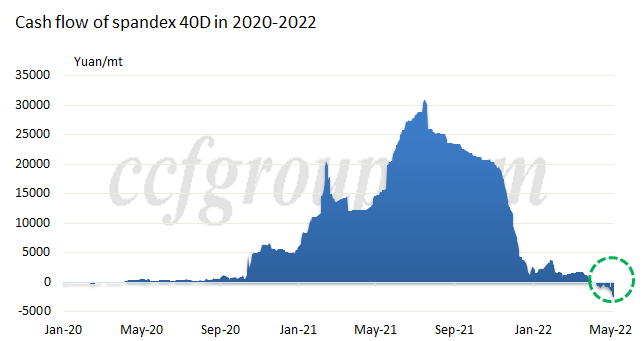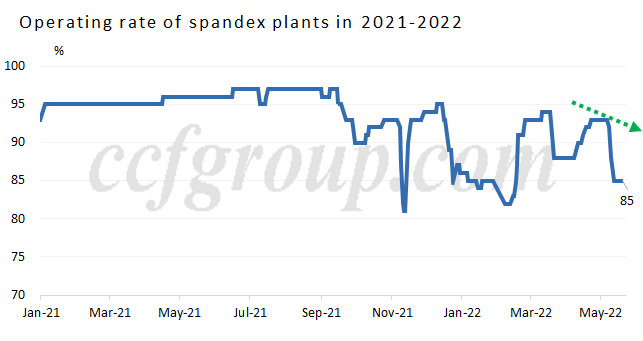Spandex output slashed &price keeps falling
Global economy faced various challenges with the spread of Omicron variant, the Russia-Ukraine conflict and worldwide inflation pressure. Spandex industry also continued witnessing pressure, with bigger divergence between supply and demand. New spandex capacity was near 200kt/year since Aug 2021. Coupled with high operating rate of the existing factories, supply of spandex rose. However, buyers mainly purchased on a need-to-basis to avert risk when domestic and export orders both performed badly. With weakly reducing price, spandex 40D and medium-to-coarse denier spandex in East China saw intensified losses. The operating rate of spandex plants apparently decreased in May after some spandex plants scaled down production. How will spandex market fare later?
Firstly, the cash flow of spandex 40D kept shrinking after price dropped weakly, which has been squeezed to be lower than the break-even line in Q2. Price of some spandex 40D rapidly declined to 43,000-45,000yuan/mt. 40D producers saw big cost pressure. Actually, 20D and 30D was still profitable while 40D was unprofitable now.

Current spandex capacity was at 1,062kt/year, and 150kt of production was scaled down. The operating rate of spandex plants has declined to 85%, down by near 10 percentage points from yearly high. However, most spandex plants still ran at high capacity. Zhejiang Sihai would suspend production for around one quarter amid technology upgrade. New units that started operation year to date almost ran at full capacity now, while the startup of some new plants was delayed with sales pressure and falling cost.
With reducing price of 20D and 30D, the cash flow may rapidly shrink later. Stocks of 20D and 30D were high. Producers that produce stagnated varieties are likely to slash output later. That means the operating rate of spandex plants may drop further.

Secondly, stocks of spandex was under uptrend, hitting one-year high. Orders for fabrics improved limitedly, especially in circular knitting field. The procurement of some non-necessities of life shrank with high inflation pressure outside China although the exchange rate of RMB has greatly depreciated against the USD. Supermarkets like the Walmart also saw mounting stocks abroad. In addition, some orders for textiles and apparels were transferred to emerging markets like Vietnam and India. Overall domestic and export orders did not increase much. Fabric, textile and apparel market performed weakly in Apr amid the pandemic. Sales ratio of spandex was at 80% in Apr, ending up with obviously higher inventory. Spandex stocks continued rising in May. Market is expected to recover in Jun while some players still held cautious mindset as they thought missed peak season was hard to be made up. Next peak season may be the “Gold Sep and silver Oct”, the traditional peak season in the second half of year.

Thirdly, capital pressure also increased. Fabric mills saw apparently deteriorating operation environment on the year in 2022. The short-distance transportation fee largely rose amid the pandemic and the delivery of export cargos took longer time at ports. The payment days of export orders were extended and the recouping of capitals under domestic sales were also slow. As a result, fabric mills and textiles and apparels producers saw tight capital. Spandex market turned to buyers’ market. With longer payment days and high spandex price in history, a large quantity of capital was occupied. Spandex capacity was under expansion peak period. Some spandex companies witnessed apparent capital pressure.
In summary, weak downstream market gradually weighed on upstream market. Domestic and export demand was meager while supply edged up stably. With better controlled spread of pandemic in Shanghai, demand may be better in Jun. However, price of fabrics and covered yarn is hard to increase and most downstream products see heavier losses, hard to improve much. After the Asian Games being postponed, fabric mills become less anxious to replenish. Fabric mills are more cautious in producing stocks after price of polyester and nylon fibers surged. Sales are unlikely to climb up much by revising down prices if demand fails to grow obviously. The losses of 40D and medium-to-coarse denier spandex have worsened. Stocks of 20D and 30D are high. Therefore, more spandex production may be reduced in Jun and Jul, which is supposed to be the traditional off-season.
- Top keywords
- Cotton Price
- Cotton Futures Price
- Cotton Futures
- CZCE
- PTA Futures Price
- Chemical Fiber
- Polyester Prices
- Wool price
- PTA Futures
- Shengze Silk
- China
- Yarn Price
- price
- China Textile City
- Fibre Price
- Benzene Price
- Cotton
- Index
- Cotton Index
- PTA
- fabric price
- NYMEX
- Top 10
- textile industry
- Spot Cotton
- Cotton Yarn
- Polyester Price
- Futures
- PTA Price
- cotton yarn price

